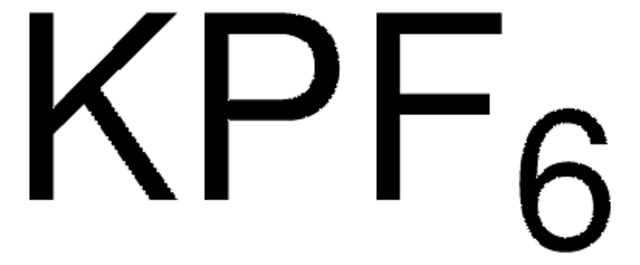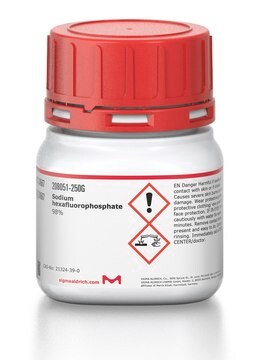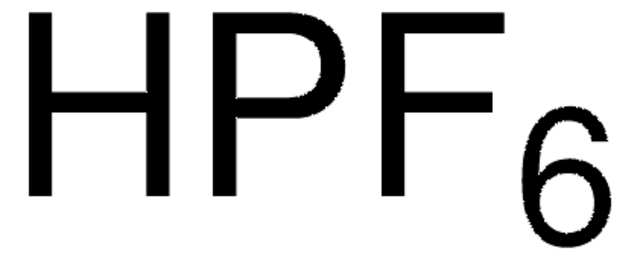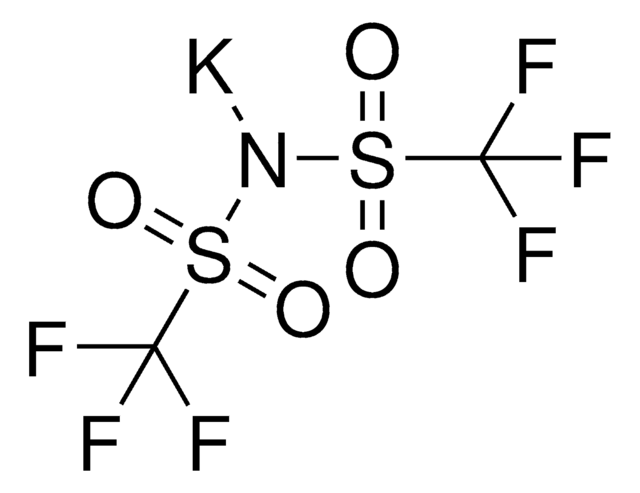Wichtige Dokumente
515973
Kaliumhexafluorphosphat
99.5% trace metals basis
Synonym(e):
Potassium fluophosphate, Potassium hexafluorophosphate, Potassium hexafluorophosphate (KPF)
About This Item
Empfohlene Produkte
Qualität
for analytical purposes
Assay
99.5% trace metals basis
Form
solid
Verunreinigungen
≤5500.0 ppm Trace Metal Analysis
mp (Schmelzpunkt)
575 °C (lit.)
Dichte
2.75 g/mL at 25 °C (lit.)
SMILES String
[K+].F[P-](F)(F)(F)(F)F
InChI
1S/F6P.K/c1-7(2,3,4,5)6;/q-1;+1
InChIKey
YZDGRYDIGCWVND-UHFFFAOYSA-N
Suchen Sie nach ähnlichen Produkten? Aufrufen Leitfaden zum Produktvergleich
Anwendung
- Multifunctional potassium hexafluorophosphate passivate interface defects for high efficiency perovskite solar cells: Potassium hexafluorophosphate (KPF6) is used to enhance the interface between SnO2 quantum dots and perovskite (Z Wang et al., 2021).
- Potassium hexafluorophosphate additive enables stable lithium–sulfur batteries: An optimized amount of KPF6 added to the electrolyte improves the cycling stability of lithium-sulfur batteries (J Li et al., 2020).
- Dual electrolyte additives of potassium hexafluorophosphate and tris (trimethylsilyl) phosphite for anode-free lithium metal batteries: KPF6 and tris(trimethylsilyl) phosphite enhance the electrochemical performance of anode-free lithium metal batteries (TM Hagos et al., 2019).
Signalwort
Danger
H-Sätze
Gefahreneinstufungen
Eye Dam. 1 - Skin Corr. 1B
Lagerklassenschlüssel
8A - Combustible corrosive hazardous materials
WGK
WGK 1
Flammpunkt (°F)
Not applicable
Flammpunkt (°C)
Not applicable
Persönliche Schutzausrüstung
Eyeshields, Faceshields, Gloves, type P3 (EN 143) respirator cartridges
Hier finden Sie alle aktuellen Versionen:
Besitzen Sie dieses Produkt bereits?
In der Dokumentenbibliothek finden Sie die Dokumentation zu den Produkten, die Sie kürzlich erworben haben.
Kunden haben sich ebenfalls angesehen
Unser Team von Wissenschaftlern verfügt über Erfahrung in allen Forschungsbereichen einschließlich Life Science, Materialwissenschaften, chemischer Synthese, Chromatographie, Analytik und vielen mehr..
Setzen Sie sich mit dem technischen Dienst in Verbindung.










